 I arrived in Shanghai at 7 a.m. this morning. I was met at the station by the staff of the Philippine Consulate. Since I had to catch my flight in Guangzhou on November 7, and the train from Shanghai to Guangzhou was close to 24 hours, I only had one full day in Shanghai. I was staying for a night at the residence of the consul-general in Shanghai who is my brod, Ambassador Jess Yabes.
I arrived in Shanghai at 7 a.m. this morning. I was met at the station by the staff of the Philippine Consulate. Since I had to catch my flight in Guangzhou on November 7, and the train from Shanghai to Guangzhou was close to 24 hours, I only had one full day in Shanghai. I was staying for a night at the residence of the consul-general in Shanghai who is my brod, Ambassador Jess Yabes. We went around the city first since Jess was expecting us at 9 a.m. So they took me to the Bund (外灘), one of the major attractions of Shanghai. The Bund is a living exhibition of buildings of various architectural styles which I wll discuss in detail later.
We went around the city first since Jess was expecting us at 9 a.m. So they took me to the Bund (外灘), one of the major attractions of Shanghai. The Bund is a living exhibition of buildings of various architectural styles which I wll discuss in detail later.From the promenade along the Bund, you could see Pudong on the opposite side of the Huangpu River and another famous landmark of Shanghai, the Oriental Pearl TV Tower (东方明珠塔), the tallest tower in Asia and the third tallest in the world.
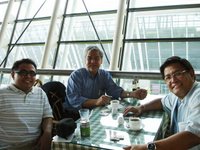 We then proceeded to the apartment where another brod, The World Tonight anchor Angelo Castro, Jr. was preparing to leave for the airport for his flight back to Manila. So after freshening up and getting settled, we proceeded to the Pudong International Airport to see Angelo off. Since there was a lot of time, we had coffee at one of the airport cafes. After Angelo left, Jess and I proceeded to The Portman Ritz-Carlton and had lunch at the Hanagatami Japanese Restaurant.
We then proceeded to the apartment where another brod, The World Tonight anchor Angelo Castro, Jr. was preparing to leave for the airport for his flight back to Manila. So after freshening up and getting settled, we proceeded to the Pudong International Airport to see Angelo off. Since there was a lot of time, we had coffee at one of the airport cafes. After Angelo left, Jess and I proceeded to The Portman Ritz-Carlton and had lunch at the Hanagatami Japanese Restaurant.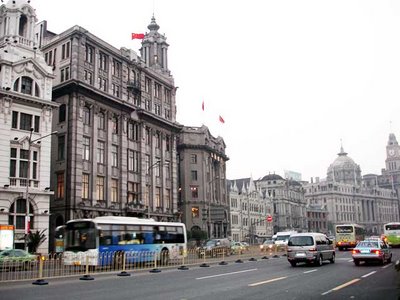 Since Jess wasn't feeling well, we went back to the apartment. I opted to rest for the afternoon too. I remember leaving the apartment at 4 p.m. to go back to the Bund. I wanted to check it out in the evening with the lighting and all.
Since Jess wasn't feeling well, we went back to the apartment. I opted to rest for the afternoon too. I remember leaving the apartment at 4 p.m. to go back to the Bund. I wanted to check it out in the evening with the lighting and all. The Bund is actually an area along the Huangpu River which served as the historical core of the city. Originally a British settlement, it was the heart of a building boom in the late 19th and early 20th centuries which made it a major financial hub of East Asia. It hosted among others banks and trading houses from the UK, France, USA, Russia, Germany, Japan, The Netherlands and Belgium, as well as the consulates of Russia and Britain, a newspaper, the Shanghai Club and the Masonic Club.
The Bund is actually an area along the Huangpu River which served as the historical core of the city. Originally a British settlement, it was the heart of a building boom in the late 19th and early 20th centuries which made it a major financial hub of East Asia. It hosted among others banks and trading houses from the UK, France, USA, Russia, Germany, Japan, The Netherlands and Belgium, as well as the consulates of Russia and Britain, a newspaper, the Shanghai Club and the Masonic Club.Many of these buildings were preserved and today, the area houses 52 buildings of various architectural styles such as Romanesque, Gothic, Renaissance, Baroque, Neo-Classical, Beaux-Arts, and Art Deco. It is said that Shanghai has one of the richest collections of Art Deco architecture in the world.
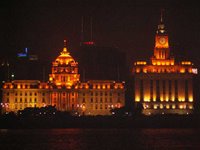 One thing I try to do when I visit a city is take a river tour since it really gives you a feel of the place. I've done it in Bangkok and Singapore, as well as Hong Kong. In developed countries, riverfront properties are very expensive.
One thing I try to do when I visit a city is take a river tour since it really gives you a feel of the place. I've done it in Bangkok and Singapore, as well as Hong Kong. In developed countries, riverfront properties are very expensive.I hope they rehabilitate the banks of the Pasig River. There are still a lot of old structures in the Manila area, a sign of its rich history. While in the Makati and Pasig City areas, political will is needed to push for the relocation of factories elswhere so that the riverbanks could be redeveloped into open spaces and recreation areas for Metro Manila's citizens to breathe.
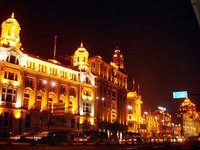 I purchased tickets for a river cruise along the Huangpu River. The day cruises are RMB45 while the night cruises are a little more expensive. But you could get the 6 to 7 p.m. cruise which is still considered a day tour, but at the same time enjoy the magnificently-lit skyline of Shanghai. Make sure you are at the ticket outlet at least 30 minutes before your tour since the port is a distance away and they have shuttle buses which transport passengers from the Bund to the port.
I purchased tickets for a river cruise along the Huangpu River. The day cruises are RMB45 while the night cruises are a little more expensive. But you could get the 6 to 7 p.m. cruise which is still considered a day tour, but at the same time enjoy the magnificently-lit skyline of Shanghai. Make sure you are at the ticket outlet at least 30 minutes before your tour since the port is a distance away and they have shuttle buses which transport passengers from the Bund to the port. The views of the Bund and Pudong from the Huangpu River were great! The cruise came with a narration in both Chinese and English, explaining the significance of the areas we passed. The only sad part was that I didn't bring my jacket since it was a little warmer in Shanghai than in Beijing. But it skipped my mind that temperatures dropped in the evening. So I guess you know what happened.
The views of the Bund and Pudong from the Huangpu River were great! The cruise came with a narration in both Chinese and English, explaining the significance of the areas we passed. The only sad part was that I didn't bring my jacket since it was a little warmer in Shanghai than in Beijing. But it skipped my mind that temperatures dropped in the evening. So I guess you know what happened.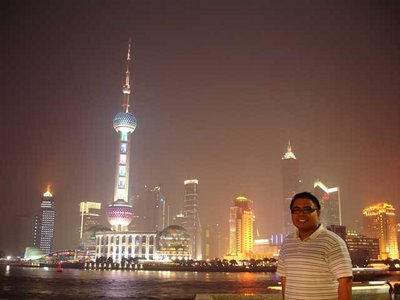 Anyway, I enjoyed the cruise. As soon as I got back to the Bund, I took photos of the Shanghai skyline as well as the buildings in the Bund.
Anyway, I enjoyed the cruise. As soon as I got back to the Bund, I took photos of the Shanghai skyline as well as the buildings in the Bund. I walked up to the Gutzlaff Signal Tower which was converted into a museum. One thing I noticed on the building was a granite marker which said "HERITAGE ARCHITECTURE." What made it more significant was the fact that it was installed by the Shanghai Municipal Government. How I wish the City of Manila would do that too instead of demolishing its heritage structures!
I walked up to the Gutzlaff Signal Tower which was converted into a museum. One thing I noticed on the building was a granite marker which said "HERITAGE ARCHITECTURE." What made it more significant was the fact that it was installed by the Shanghai Municipal Government. How I wish the City of Manila would do that too instead of demolishing its heritage structures!Tomorrow I leave for Guangzhou by train at 11:26 a.m.

I really like your comment about Pasig River. Just like you, I travel in different countries and envision how a certain area in Metro Manila or NCR could actually be develop. I'm glad you live in the Philippines and hope you may (one day) be able to contribute to the beautification/gentrification of Metro Manila.
ReplyDeleteIvan, guess you're having a blast out there! Anyway, great article especially about Pasig River! YOU have a vision! Like you, I travel to different countries and often dream about how a certain area in Metro Manila (NCR) could be develop. Fortunately, you live in the Philippines and hope (one day) that you'll be able to successfully make your vision to beautify/gentrify a city in the Philippines a REALITY!!!
ReplyDeletei remember hearing stories from my great-grandfather about how beautiful pasig river was. he used to bring goods to manila via the river and would tell us that in the afternoons, people would actually stroll by the pampang (riverbank). while i do commend the current efforts on saving pasig river, i can't help but wish that we could turn back time and keep that river pristine.
ReplyDeleteThanks ocjpr! I now studying urban planning in UP and funny thing, the prof assigned me the Pasig River rehabilitation for my paper. Hehe!
ReplyDeleteHi Weye! Actually most rivers in the Philippines had those stories attched to them. Gone are those days of clean rivers.